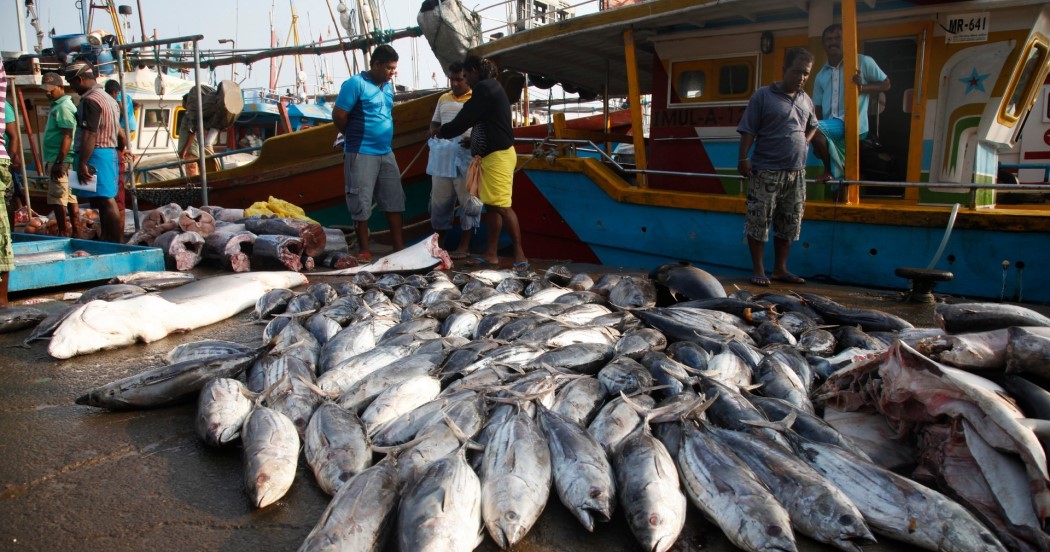
Thanks to its insular nature and ideal climate conditions, the teardrop of Sri Lanka hanging from the northernmost tip of India is home to an abundance of fisheries products. As a major exporter in the field, we export both fish as food and ornamental fish to a considerable number of international markets including the USA, Japan, Germany, Belgium and the Netherlands. In 2019 alone, 24,673,914 kg of edible fish left the shores of Sri Lanka and headed to global markets. At present, the fisheries sector contributes about 2% to the GDP and the country is increasingly investing in R&D and infrastructure related to the fisheries industry, having realized the potential of this ever-green industry.
The century-old fishing culture of Sri Lanka has now evolved into a multi-gear sector focusing on multi-species. However, it does not mean that Sri Lankan fisheries communities have abandoned the knowledge and expertise passed down from generation to generation; traditional fishing tools and techniques are still being employed, retaining the character of the local industry. For example, the principal harvesting method used in the recent past was the beach seine which is considered to be the backbone of the industry. Following right next is the method of still fishing. Known amongst locals as ‘Riti Panna,’ stilt fishing fishermen dotting the amber-scarlet horizon is a picture-perfect shot that often features souvenir postcards from Sri Lanka.
In addition, Sri Lanka also uses modern methods to harvest fish such as trawling, trolling, gillnetting, longlining, purse seining etc.
Used in coastal fishing, the beach seine is a surrounding net operated with two long ropes. It is placed in a circular shape, encircling a school of fish living close to the shore. The net is dragged ashore by hand with the fish gathered into the appendix-like structure in it. Usually, a single unit is about 500 meters long and covers around 2 ha of the sea. Beach seine was considered to be the single most contributor to the coastal fisheries in the early days and it is estimated that there were around 3000 active units in 1960- 1963. To date, it remains a major player amongst coastal fishing communities and long lines of fishermen battling with the heavy net coming out of the sea is a common sight along the sea line.
The lift net is a traditional fishing gear still used in Sri Lanka. The process of harvesting fish using lift nets involves submerging the net in the ocean. Once it reaches a certain depth, the fishermen would lift the net and collect the fish caught in it. Usually, they use bait to lure fish into the net. Also called lever nets, lift nets come in several shapes like rectangular nets, pyramid nets and cone nets.
The Sri Lankan fish industry employs several types of gillnets such as; the large meshed drift gillnet, the small meshed gillnet, and the bottom-set gillnet. Used by motorized fishing vessels, gillnets target a variety of species including large demersal, tuna, king mackerel, and sardines. Due to the greater damage it causes to similar species like sharks and dolphins, gillnets are currently being discouraged and fishermen are prompted towards alternative fishing methods.
Somewhat similar to gillnets, the trammel net is made up of two or three net layers. There is a small mesh netting between the two layers of large mesh netting and that is where the fish catch will be entangled. Used by motorized vessels and often hauled by hand, trammel nets target demersal species and fish. In Sri Lanka, trammel netting is widely used for effective lobster harvesting.
Trawling is a fishing method that involves dragging a cone-shaped net through the waters. The net is held open by its plates. Fish swimming in the way of the net gets caught in the cod end – or the rear end of the net. There are two kinds of trawling: bottom trawling and midwater trawling. In Sri Lanka, fishermen target shrimps and demersal with their trawl nets and use both motorized and non-motorized fishing vessels for trawling.
The Sri Lankan fishing fleet includes both indigenous and introduced crafts.
For instance, outrigger canoes, log-rafts, beach-seine crafts and planked crafts are some of the most commonly used indigenous crafts in Sri Lanka.
The accelerated development in the fisheries industry that occurred over the past few decades led to the introduction of modern crafts as well. As a result, the Sri Lankan fishing fleet also includes modern large scale boats such as 3½ ton boats, 5.3-5.7 m FRP boats, 11.6 m ‘ADB project boats’, 10.4 m ‘Abu Dhabi project boats’, Trawlers (236 GT) and 13-1 4 m Ferro-cement trawlers.
The Sri Lankan fisheries industry functions under rigid rules and regulations aimed at sustainability and environmental protection. For example, in terms of harvesting methods, Sri Lanka prohibited oceanic longlining in the 1980s. Push net fishing, bottom-set gillnets, harpooning for marine mammals and trammel nets are banned in coral reef areas while light-lure purse seines are not allowed in the country’s coastal areas. Among other regulations, trawling is also banned in certain areas.
Sri Lanka’s seafood product sector has emerged as a quality exporter of a wide variety of fish, with the most popular of them being tuna. Sri Lanka’s rich and relished seafood of different varieties are available through an extensive network of exporters.